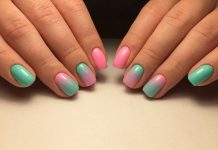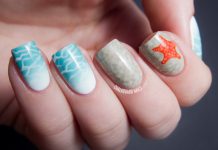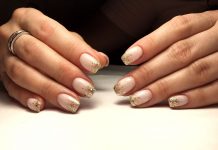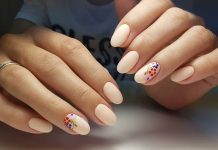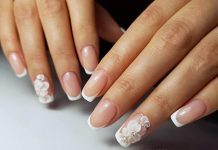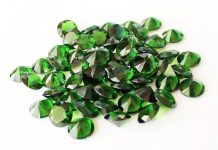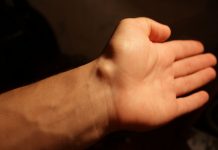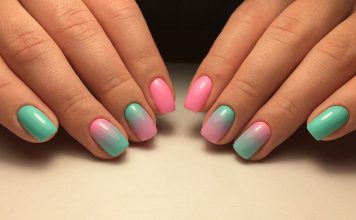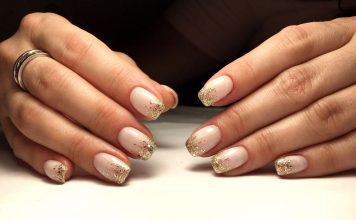Even the most luxurious nail design will not look good without proper prior preparation. This classic cut manicure is a preparatory stage for any other type of manicure. First of all, it is a hygienic procedure.
This procedure has several names: “classic”, “edged”, “wet”. But they all mean one type of care event. In the process of cutting off the regrown cuticle and hardened skin around the nails. There is an alternative method - unedged manicure. It is less traumatic and is more popular in Europe and the USA.
Among the advantages of trimming manicure is the ease of execution and the minimum set of necessary tools. This procedure will allow to achieve a well-groomed look of hands, even in very neglected cases.
Do not miss the disadvantages: for high-quality manicure you need experience and skill. There is also a risk of skin damage and infection in the wound.To prevent this, you need to study the detailed instructions and not deviate from the plan.
Manicure step by step
To get started you need to collect the necessary tools. How to choose the best from the range offered in the market, let's talk later. The minimum set will consist of a tool for moving back the cuticle, a nail file for working with natural nails, nail scissors with straight lines and rounded ends.
First, it is recommended to remove the old coating, sanitize nails and tools. Next, you should perform the following manipulations in stages:
- We work on the length and shape of the nails. With the help of straight scissors we bring all the nail plates to the same length. The shape of the free edge is created using a nail file. An important caveat: to protect the nails from splitting, it is necessary to file them only in a dry form. In the process of cutting the nail file should be sent at a right angle to the edge of the nail plate. This method also protects the nails from lamination.
- Cooking bath. At this stage, the meaning of the name “wet manicure” is revealed. Before removing the cuticle and hardened skin need to soften. This is what the hand bath serves for. Salt, soap, essential oils, herbal extracts and other ingredients can be added to the water at a pleasant warm temperature. You can perform the procedure in just 5 minutes.

- Separate the cuticle. To do this, use a pusher or an orange stick. With their help, with a slight movement we move the cuticle as close as possible to the base of the nail. This should be done carefully, as a softened nail can be damaged by pressing too hard with the sharp end of the tool. Also, injuries can be avoided by the special position of the instrument - it should supposedly lie on the nail plate. Then pressing on the base of the nail will be completely weightless.

- Remove the cuticle. This is the most traumatic moment. You should choose the most convenient tool (rounded scissors, pliers) in order to cut off just as much excess skin as you need to preserve the integrity of the skin. Slow movements need to cut the cuticle and excess skin on the rollers.

- The previous stage can be considered the last in a manicure, but for healthy care of hands it is worth holding a number of additional procedures. For example, you can apply cuticle oil or nail growth, massage your hands or use some kind of specialized mask.

The key to a healthy look is not the fundamentally new or fashionable type of manicure that you have chosen, but the regularity and accuracy of the procedures. Only if you follow the regime with a monthly hygienic manicure, you can hope to achieve the desired effect.
The choice of tools for trimming manicure
The effectiveness of the cut manicure procedure largely depends on the quality of the tools. Of course, experts recommend choosing professional branded items. Their advantages are obvious. Durability and reliability will allow the tools to keep working capacity much longer than cheaper analogues will do. The metal in the composition of materials for the manufacture has medical properties. It does not oxidize and does not suffer from rust. Any moving part of the tool is securely fastened. Such a product is not able to break during processing and injure the hands of the client. The tool is easy to hold and manipulate.
As an option - the purchase of complete sets. There are both advantages and disadvantages. Conveniently, everything is packaged in one cosmetic bag. The disadvantage is that such kits are often supplemented with completely unnecessary items for which you have to pay extra money.
Before buying tools you need to clarify the list of all necessary:
- Straight cut nail scissors;
- Curved nail scissors;
- Nippers;
- Files (several varieties);
- Paddles (wooden orange sticks);
- Forceps;
- Knipsery.
- Choosing Scissors
It is important to ensure that the scissors are sharpened on the blade and at the edges. Conveniently, if the handles are rubberized.But it is perfectly acceptable to use medical fusion in this part of them. To check the degree of sharpening, you need to take the scissors in the non-working hand and try to cut the nail off the second hand. Even in this case, the cut should be smooth, without cliffs and chipping.
There are a number of varieties: universal scissors for nails, cuticle and hardened skin; for nails and cuticle separately.
How to choose nippers
Good nippers should not twitch the skin and leave burrs. They vary in size and width. Before purchasing it is important to check whether it is convenient to hold the tool in your hand and use it. High-quality cutters have a well-ground working area, the edges of which are tightly closed at rest.
Nail files
A professional master in the arsenal should have at least ten different nail files. For home use, two is enough. They are divided into several types. Glass nail files are needed for decorative manicure. They are convenient to issue extended nails. You can sterilize them with ultraviolet light or high temperature. Prague glass for such tools has become the most popular due to its durability.
Metal models with diamond dust are particularly practical. They are convenient to handle thin and short natural nail plate. Such files are better to choose from the range of expensive firms, since cheap products quickly oxidize and lose their properties.
Buffs are designed to give the nails a mirror smoothness. This is a bar or a nail file with a fine abrasive. They can be suede, woven, made of recycled polyethylene foam. The last option is the most accessible and easy to maintain.
The scraper is another optional but handy tool. It is a stick with a spatula at one end and a sharp edge to remove dirt at the other. This item must be made of medical steel.
The manicure trimmer is a deburring and cuticle remover knife. You can check the tool on plain paper. If the trimmer easily cuts a piece of paper, then it will fully cope with the task.
A little diligence in training and a good set of tools can make anyone a master in the art of cut manicure.


